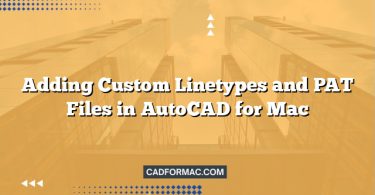If you’re transitioning from AutoCAD for Windows to AutoCAD for Mac—or you’re simply trying to customize your workflow on macOS—you may be wondering where the familiar ACAD.PGP file is located. On Windows, this file stores command aliases (shortcuts) that let you type abbreviated versions of commands (e.g., typing L instead of LINE). However, AutoCAD for Mac handles command aliases differently, and understanding how to locate and edit them is key to customizing your experience.
Why There’s No ACAD.PGP on Mac
AutoCAD for Mac does not use the traditional ACAD.PGP (Program Parameters) file that Windows users are accustomed to. Instead, command aliases are stored in a different format and location, reflecting macOS’s distinct file system and application architecture.
Where Are Command Aliases Stored in AutoCAD for Mac?
In AutoCAD for Mac, command aliases are defined in a file called acad.pgp, but it resides in a different directory than on Windows. The file is typically located within the application support folder for your specific AutoCAD version.
Default Location
The standard path for the acad.pgp file in AutoCAD for Mac is:
~/Library/Application Support/Autodesk/AutoCAD 20XX/Rx.x/enu/Support/acad.pgp
Replace:
- 20XX with your AutoCAD year (e.g., 2024)
- Rx.x with the release number (e.g., R24.3)
Note: The
~symbol represents your user home directory (e.g.,/Users/yourusername).
How to Access the File
- Open Finder.
- Press Command + Shift + G to open the “Go to Folder” dialog.
- Paste the path above (adjusting for your version), for example:
~/Library/Application Support/Autodesk/AutoCAD 2024/R24.3/enu/Support/ - Press Go.
- Locate and open acad.pgp with a text editor like TextEdit (in plain text mode) or a code editor like VS Code or BBEdit.
Caution: Always back up the original
acad.pgpfile before making changes.
Understanding the acad.pgp File Format
The structure of the acad.pgp file on Mac is nearly identical to its Windows counterpart. Each line defines an alias using the following syntax:
alias, *command
For example:
L, *LINE
C, *CIRCLE
CO, *COPY
- The part before the comma is the alias (what you type).
- The part after the comma (preceded by an asterisk) is the full command name.
You can add your own custom aliases using the same format. Just insert new lines at the end of the file or in the appropriate section.
Applying Your Changes
After editing and saving the acad.pgp file:
- Restart AutoCAD for Mac, or
- Type REINIT in the command line, press Enter, then check PGP File in the dialog box and click OK.
This reloads the alias definitions without requiring a full restart.
Here’s a comparison table highlighting key differences between AutoCAD for Windows and AutoCAD for Mac, specifically focused on command aliases and customization—the core topic of your article:
AutoCAD for Windows vs. AutoCAD for Mac: Command Aliases & Customization Comparison
| Feature | AutoCAD for Windows | AutoCAD for Mac |
|---|---|---|
| Alias Configuration File | acad.pgp (Plain text file) |
acad.pgp (Plain text file) |
| Default File Location | C:\Users\<username>\AppData\Roaming\Autodesk\AutoCAD <version>\R<release>\enu\Support\acad.pgp |
~/Library/Application Support/Autodesk/AutoCAD <version>/R<release>/enu/Support/acad.pgp |
| GUI Tool for Editing Aliases | Yes – Use ALIASEDIT command to open alias editor dialog | No – ALIASEDIT command is not available |
| Editing Method | Can edit via GUI (ALIASEDIT) or manually in text editor | Manual editing only (using a plain-text editor) |
| File Format & Syntax | alias, *COMMAND (e.g., L, *LINE) |
Identical syntax: alias, *COMMAND |
| Reload Aliases Without Restart | Use REINIT → Check “PGP File” → OK | Same: Use REINIT → Check “PGP File” → OK |
| User Customization Support | Full support; widely documented | Full support, but less intuitive due to hidden Library folder and no GUI |
| Backup & Version Safety | Custom acad.pgp preserved across updates (if in correct folder) |
May be overwritten during major updates—manual backup recommended |
| Accessibility for New Users | Easier due to GUI tools and familiar Windows paths | More technical; requires knowledge of macOS file system and hidden folders |
Tip for Mac Users: To access the
~/Libraryfolder in Finder, hold the Option key while clicking the Go menu, or use Cmd + Shift + G and type~/Library.
This table underscores that while both platforms use the same underlying alias system (acad.pgp), AutoCAD for Mac lacks the user-friendly ALIASEDIT interface, making manual file editing essential for customization.
Alternative: Using the ALIASEDIT Command (Not Available on Mac)
On Windows, users can run the ALIASEDIT command to open a dialog box for managing aliases. This command is not available in AutoCAD for Mac, so manual editing of the acad.pgp file remains the only method for customization.
Tips for Managing Aliases on Mac
- Keep a backup of your customized
acad.pgpfile to restore after software updates. - Use a plain-text editor—rich text editors may add formatting that corrupts the file.
- Check for duplicates—adding an alias that already exists may cause unexpected behavior.
- Review Autodesk’s default aliases before making changes to avoid overriding standard shortcuts unintentionally.
FAQ: Command Aliases in AutoCAD for Mac
Q1: Can I use my Windows acad.pgp file directly on AutoCAD for Mac?
A: Yes! The file format and syntax are identical. You can copy your customized Windows acad.pgp file to the Mac support folder (after backing up the original), and it will work as long as the command names exist in the Mac version. However, note that a few commands differ between platforms (e.g., PLOT vs. PAGESETUP workflows), so test thoroughly.
Q2: Why can’t I see the Library folder in Finder when trying to locate acad.pgp?
A: On macOS, the ~/Library folder is hidden by default. To access it:
- Open Finder,
- Press Cmd + Shift + G,
- Type
~/Libraryand press Go.
Alternatively, hold the Option key while clicking the Go menu in Finder—Library will appear as a temporary option.
Q3: After editing acad.pgp, my new aliases aren’t working. What should I check?
A: First, ensure:
- You edited the correct
acad.pgpfile (verify the AutoCAD version in the path). - There are no syntax errors (e.g., missing commas or asterisks).
- You reloaded the file using the REINIT command and selected PGP File.
- You’re not using an alias that conflicts with an existing command or reserved keyword.
Q4: Does AutoCAD for Mac support user-defined command aliases for LISP routines or custom scripts?
A: Yes! You can create aliases for custom commands, including those defined in AutoLISP (.lsp) or .bundle files. For example:
MYCMD, *MYCUSTOMLISPCOMMAND
Just ensure the custom command is loaded and available in the current session before using the alias.
Q5: Will my custom acad.pgp be deleted when I update AutoCAD for Mac?
A: It depends. Minor updates usually preserve support files, but major version upgrades (e.g., AutoCAD 2024 → 2025) may reset or overwrite the default acad.pgp. Always back up your customized file before updating, and reapply it afterward if needed.
Q6: Can I have multiple alias files or load aliases from a different location?
A: AutoCAD for Mac only loads aliases from the primary acad.pgp in the official Support folder. Unlike Windows, it does not support the ACADALIAS system variable or multiple PGP files. All aliases must be included in the main acad.pgp.
Q7: Are there any Mac-specific keyboard shortcuts that conflict with custom command aliases?
A: Not directly—command aliases are typed in the command line and don’t interfere with macOS system shortcuts (e.g., Cmd+C for copy). However, be cautious with single-letter aliases like V or W, as they might be used by built-in commands or third-party plugins.
Conclusion
While AutoCAD for Mac doesn’t expose command aliases through a GUI like its Windows counterpart, the underlying system is still accessible via the acad.pgp file in the Application Support directory. By locating and editing this file, Mac users can fully customize their command shortcuts to match their workflow preferences—bridging the gap between platforms and boosting productivity.
Whether you’re replicating your Windows setup or creating a new set of shortcuts tailored to macOS, understanding where and how AutoCAD for Mac stores aliases puts you in control of your design environment.




